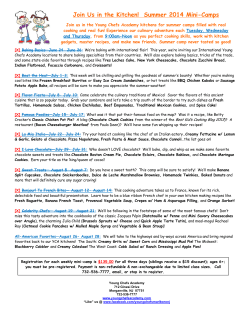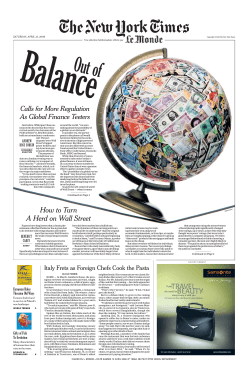
I. Cover Sheet 1
I. Cover Sheet 1 The Invention of Chocolate: The Archaeological Origins of Cacao (Theobroma cacao) in the Americas II. Summary This research will document whether the invention of chocolate, dating back more than 39 centuries, was consumed as either a seed product or a fermented beer by indigenous peoples of Mesoamerica and South America. It involves testing methods that would permit chemical signatures of the two different types of cacao beverages to be distinguished. I will then use these methods to analyze samples from two of the earliest sets of ceramic drinking vessels in the New World. Resulting scholarship includes two presentations, two peer-reviewed articles, and one workshop/seminar. The results of my research will be incorporated into my teaching. 2 III. Narrative A. Project Description How, where, and when did indigenous people first start using cacao? The cacao tree was first domesticated in the humid tropical lowlands of northern South America and then spread north to Mexico. Ethnohistorians and archaeologists have documented the history of chocolate use in Mesoamerica and have correlated this production with specific types of ceremonial pottery. Archaeological research has now suggested that cacao reached the Pacific Coast of Chiapas, Mexico by at least by 3,900 years ago (Powis et al. 2008; Powis et al. 2011). However, whether cacao was initially consumed as a seed product (made from cacao ―beans‖ that were dried, toasted and ground into chocolate) or as a fermented beer (made from the sweet white pulp that surrounds the cacao seeds) remains to be determined (Henderson et al. 2007). The question is one of critical importance to understanding the history and evolution of a key global food that has been elaborated into a myriad of culinary products, most of which would be completely unrecognizable to the indigenous inventors of chocolate in ancient Mexico and South America. The first component of this project is a pilot study to clarify and develop new methods for identifying the chemical and micro-botanical ―fingerprints‖ of cacao that can be recovered from residues found on the interior surfaces of ancient pottery fragments. Such analyses would allow the determination of whether the earliest use of cacao focused on the seeds to make chocolate or the pulp to make beer. The laboratory methods also call for precise dating of cacao-related residues using high precision radiocarbon dating, thereby determining the exact age of initial cacao use. The second component of the project is to test these new laboratory methods by analyzing examples of the earliest pottery in the Americas to determine whether or not there is evidence of cacao residues in any of these vessels. Samples from two of the earliest known 3 collections of drinking vessels will be taken: (1) the Barra phase (3,900 years old) house deposits at Paso de la Amada, Chiapas, Mexico; and (2) the Mayo-Chinchipe phase (4,500 years old) tombs at Santa Ana-La Florida in Ecuador. Research Methods Fresh samples of cacao fruits (pods) have recently been collected from cacao plantations in Mexico, Costa Rica, and Brazil and will be evaluated for variation within/among the varieties grown in different regions. I expect to find differences in the types and quantities of compounds in beans vs. the pulp—a differentiation that has never before been explored in detail and applied in an archaeological context. By characterizing these differences, I will be able to identify whether ancient pots contained residues that originated from beans, pulp, or both. This in turn will allow for a better understanding of the first steps in the history of cacao-chocolate use and its social and culinary significance as humans introduced the plant into new regions outside its native range. Analysis of the raw cacao seeds and pulp, as well as the archaeological pottery residues, will require the use of mass-spectrometry and chromatography. The members of my interdisciplinary research team who will conduct this part of the project are Dr. Nilesh Gaikwad (Assistant Professor of Nutrition) and Dr. Louis Grivetti (Professor of Nutrition) at the University of California at Davis. Using state-of-the-art laboratory facilities at UC-Davis, they will prepare cacao beer samples using fermented pulp only and another using pulp fermented along with beans. They will then identify how the two types of residues may be distinguished by their chemical signatures, allowing for future differentiation between the presence of chocolate – in the strict sense – and that of cacao used in the form of fermented beers. A large sample size will allow us to determine the proportion of specimens that have preserved cacao residues and it 4 will increase the chances that we will be able to distinguish between bean versus pulp residues: 150 samples from Paso de la Amada (collected in August 2011), and the same number of sherds collected in Ecuador in May 2012. Findings from analysis conducted at UC-Davis will allow us to test the hypothesis that the earliest use of cacao was for fermenting an alcoholic beverage rather than the non-alcoholic chocolate drink that became prevalent in Mesoamerica by about 2,000 years ago. Enhancement of Teaching, Research, and Service As often as possible I relate my research to my teaching. My students identify with this approach and feel that I am more competent in the subject area when I bring in my own research for teaching purposes. I believe that an active research agenda enhances teaching effectiveness. Being able to speak about a project from start to finish, with the kind of expertise that only comes from coordinating your own research project, is a particularly effective way of getting students interested in a subject. It also lets them see the relevance of the work they are doing in class and see why certain kinds of procedures are specified in a scientific enterprise. While it is certainly possible to teach about research methods without utilizing one’s own research, I find that the topic comes alive in class when lectures are based on personal experience. Students learn not only about intellectual curiosity, but also about the relevance of the research, the methodological and theoretical rigor, and professional integrity. In the short-term, fifteen KSU students attending my Belize Archaeology Field School in the summer of 2012 will be involved in this research as they travel with me to visit archaeological sites where early evidence of cacao has been found as well as to cacao orchards owned by Maya farmers. In the longer term, this learning experience clearly fits into the department’s emphasis on experiential learning, the 5 college’s goals to enhance global citizenship, and the university’s emerging focus on engaged scholarship. My project will span the natural-social science divide, linking the two domains with a common research goal to understand the history of one of the world’s important economic crops. As an archaeologist working with biochemists, geographers, nutritionists, and paleo-botanists, the logical collaborators to answer questions regarding the domestication and early use of cacao and provide a definitive answer to the most elusive question of all: did the earliest users of cacao make a beverage out of the beans—much like modern chocolate or did they ferment the sugary pulp surrounding the beans and prepare a socially and, perhaps, ritually important beer? For all the project specialists, this project presents a timely opportunity to develop new analytical methods and techniques that, relying on interdisciplinary collaboration, will contribute equally to the social and natural sciences. All of the resources I need to conduct my cacao research have already been secured. Currently, I am a co-investigator on two external grants: (1) Wenner Gren grant ($18,960) awarded to Richard Lesure (UCLA) for the project ―Paso de la Amada and the Origins of Ancient Mesoamerican Civilization‖; and (2) Hampton Fund Research grant ($37,922) awarded to Michael Blake (UBC) for the project ―The Archaeological History of Cacao Use‖. Sustainability For me, this project represents a new research direction. I have been studying both the emergence of complex social and political organizations in Mesoamerica and the origins and spread of cacao throughout this region for the past twelve years. During research in 2006 I discovered that one of the potsherds from Paso de la Amada contained the complex organic compound theobromine. At the time of this writing, this is still considered the earliest known 6 example of chocolate use in prehistory, prompting consideration of the role of chocolate in the economy and society of these ancient villagers. New research building on this discovery cannot be carried out, however, without the development of new methods of both chemical and microscopic analyses of residues on archaeological artifacts. The interdisciplinary nature of this research will lead to new methodologies for extracting and identifying the chemical signatures of cacao. It presents an opportunity to develop further and expand our expertise in archaeological investigations of human nutrition and the biochemistry of ancient food use. C. Dissemination Upon completion of the analyses, the expected outcomes of the proposed research are published descriptive reports of our new methods and more theoretical discussions of the implications of our findings. We expect to target peer-reviewed scholarly journals where the results will continue the debates and discussions that have been widely published in the past decade. Because the scope of our work is international, interdisciplinary, and will break new methodological and analytical ground, our target journals are: Nature, Proceedings of the National Academy of Science (PNAS), and Science. We also expect to publish more detailed archaeological analyses in the following journals: Latin American Antiquity, Antiquity, and Current Anthropology. Papers describing the nutritional and bio-chemical implications of our work will be published in: Biochemical and Biophysical Research Communications, Nutrition Today, and Ecology of Food and Nutrition. We also plan to publish in Spanish in both Mexican and Ecuadorian publications. All members will participate in academic conferences, the first of which will be the annual meeting of the Society for American Archaeology in Honolulu, Hawaii in March, 2013. 7 Works Cited Henderson JS, Joyce RA, Hall GR, Hurst WJ, and McGovern PE. 2007. Chemical and archaeological evidence for the earliest cacao beverages. Proceedings of the National Academy of Sciences 104(48):18937-18940. Powis T, Hurst WJ, Rodríguez C, Ortíz C. P, Blake M, Cheetham D, Coe MD, and Hodgson JG. 2008. The Origins of Cacao Use in Mesoamerica. Mexicon 30(2):35-38. Powis TG, Cyphers, A., Gaikwad, N., Grivetti, L., and Cheong, K. 2011. Cacao Use and the San Lorenzo Olmec. Proceedings of theNational Academy of Science 108(21) 8595-8600. 8 IV. Project Schedule Timeline Summer 2012 travel to Ecuador, funding already secured for this research, to obtain 150 samples for chemical testing Spring 2013 complete lab analysis and begin write-up of results with colleagues from UC-Davis by Spring Break Spring 2013 write grant for research continuation in summer 2014 June 2013 present results paper at the annual Belize Archaeology Symposium August-September 2013 submit peer-review article (more methodological) on Invention of Chocolate to the journal Latin American Antiquity Fall 2013 conduct a workshop or seminar for colleagues on the outcomes of my sabbatical Fall 2013 present research at Student Anthropology Club and department chapter of the Lambda Alpha Anthropology Honors Society Spring 2014 submit second (more theoretical) article to a peer-reviewed journal (e.g., Ancient Mesoamerica) 9 V. Curriculum Vita CURRICULUM VITAE Terry G. Powis, Ph.D. Associate Professor of Anthropology Department of Geography and Anthropology Kennesaw State University MD 2203, SO Bldg. 22, Rm. 4048 678.797.2174 tpowis@kennesaw.edu EDUCATION 1997-2002 Ph.D., University of Texas, Austin, Anthropology 1993-1996 M.A., Trent University, Peterborough, Ontario, Canada, Anthropology 1982-1987 B.Sc., Trent University, Peterborough, Ontario, Canada, Anthropology PROFESSIONAL EXPERIENCE BELIZE, CENTRAL AMERICA 2008-present Principal Investigator, Pacbitun Regional Archaeological Project (PRAP), Kennesaw State University, Kennesaw, Georgia. 1998-2007 Archaeologist and Ceramicist, Lamanai Archaeological Project (directed by Dr. Elizabeth Graham of the Institute of Archaeology, University College London). HONORS, AWARDS, AND FELLOWSHIPS 2011 Faculty Mentor, University Scholars Outstanding Senior Award for Study Abroad and Global Initiatives to Vicki Gloer 2009 College of Humanities and Social Sciences Nominee for the KSU Foundation Prize in Research for the article entitled: The Origins of Cacao Use in Mesoamerica by Powis, T., W. Jeffrey Hurst, Maria del Carmen Rodriguez, Ponciano Ortiz C., Michael Blake, David Cheetham, Michael Coe, and John Hodgson. The article was published in the peerreviewed journal Mexicon (Volume 30:35-38) in April 2008 2009 Department of Geography and Anthropology Nominee for the KSU Foundation Prize in Research for the article entitled: The Origins of Cacao Use in Mesoamerica by Powis, T., W. Jeffrey Hurst, Maria del Carmen Rodriguez, Ponciano Ortiz C., Michael Blake, David Cheetham, Michael Coe, and John Hodgson. The article was published in the peerreviewed journal Mexicon (Volume 30:35-38) in April 2008 $200 2007 Mentor of an Undergraduate Scholar of Research and Creative Activities from the Center for Excellence in Teaching and Learning (CETL), Kennesaw State University 10 SCHOLARSHIP OF TEACHING:RESEARCH AND CREATIVE ACTIVITY PUBLICATIONS * denotes co-authorship with KSU students Scholarly Books (Editor): Powis, T. 2005 New Perspectives on Formative Mesoamerican Cultures. British Archaeological Reports (BAR), International Series 1377, Oxford, England. It contains 17 chapters and 212 pages focusing on trade, exchange, and interaction during the Formative period (2000 BC – AD 250) in Mesoamerica. Refereed Journal Articles: Powis, T., Ann Cyphers, Nilesh W. Gaikwad, Louis Grivetti, and Kong Cheong 2011 Cacao Use and the San Lorenzo Olmec. Proceedings of the National Academy of Science 108(21):8599-8600. Ann Cyphers, T. Powis, Nilesh Gaikwad, Louis Grivetti, Kong Cheong, and Elvia Hernandez Guevara 2011 Nuevas evidencias el uso del cacao entre los Olmecas de San Lorenzo. Manuscript under review at Arqueologia, Instituto Nacional de Antropologia y Historia (INAH), Mexico City, Mexico. Cheong, Kong, Paul F. Healy, and T. Powis 2011 Music and the Maya: Late Classic Ocarinas and Flutes from Pacbitun, Belize. Manuscript under review at Latin American Antiquity. Powis, T., W. Jeffrey Hurst, Maria del Carmen Rodriguez, Ponciano Ortiz C., Michael Blake, David Cheetham, Michael Coe, and John Hodgson 2008 The Origins of Cacao use in Mesoamerica. Mexicon 30 (2):35-38. Powis, T., Jason Whatley*, Mary Lumsden*, Patrick Severts, Ron Hobgood, and James Page 2007 Defining a Civil War Battlefield: Recent Archaeological Investigations at the Pickett’s Mill State Historic Site, Paulding County, Georgia. Georgia Journal of Science 65(4):148-160. Powis, T., F. Valdez, Jr., T. Hester, and W.J. Hurst 2002 Spouted Vessels and Cacao Use Among the Preclassic Maya. Latin American Antiquity 13(1):85-106. Colas, P.R., C. Helmke, J. Awe, and T. Powis 2002 Epigraphic and Ceramic Analyses of Two Early Classic Maya Vessels from Baking Pot, Belize. Mexicon XXIV(2):33-39. Hurst, W.J., S.M. Tarka, T. Powis, F. Valdez, Jr., and T. Hester 2002 Cacao Usage by the Earliest Maya Civilization. Nature 418:289-290. 11 Aimers, J., T. Powis, and J. Awe 2000 Preclassic Period Round Structures of the Upper Belize River Valley. Latin American Antiquity 11(1): 71-86. Powis, T., N. Stanchly, C. White, P. Healy, J. Awe, and F. Longstaffe 1999 A Preliminary Reconstruction of Middle Preclassic Maya Subsistence Economy at Cahal Pech, Belize. Antiquity 73: 364-376. Non-Refereed Journal Articles: Powis, T., W. Jeffrey Hurst, Maria del Carmen Rodriguez, Ponciano Ortiz C., Michael Blake, David Cheetham, Michael Coe, and John Hodgson 2007 Oldest Chocolate in the New World. Antiquity 81(314). http://antiquity.ac.uk/ProjGall/powis/index.html Refereed Chapters in Books: Healy, P.F, D. Cheetham, T. Powis, and J. Awe 2004 Cahal Pech: The Middle Formative Period. In The Ancient Maya of the Belize Valley: Half a Century of Archaeological Research, ed. by J.F. Garber, pp.103-124. University Press of Florida, Gainesville. Powis, T. 2004 The Role of Pottery and Food Consumption Among Preclassic Maya Commoners at Lamanai, Belize. In Ancient Maya Commoners, edited by F. Valdez and J. Lohse, pp.4972. University of Texas Press, Austin. Refereed Proceedings (peer-reviewed): Weber, Jennifer, and T. Powis 2011 The Role of Caves at Pacbitun: Peripheral to the Site Center or Central to the Periphery? Research Reports in Belizean Archaeology 8:199-208. Powis, T. 2010 Preliminary Investigations of Three Cave Sites in the Periphery of Pacbitun, Belize. Research Reports in Belizean Archaeology 7:153-160. Powis, T., Paul Healy, and Bobbi Hohmann 2009 An Investigation of Middle Preclassic Structures at Pacbitun, Belize. Research Reports in Belizean Archaeology 6:169-178. Powis, T., and David Cheetham 2007 From House to Holy: Formative Development of Civic Ceremonial Architecture in the Maya Lowlands. Research Reports in Belizean Archaeology 4:177-186. Powis, T., Linda Howie, and Elizabeth Graham 2006 Compositional and Stylistic Variability of Late Preclassic and Protoclassic Ceramics at Lamanai, Belize. Research Reports in Belizean Archaeology 3:129-146. 12 Powis, T. 2003 Preclassic Maya Spouted Vessels: A Contextual Analysis. Journal of the Mesoamerican Archaeological Research Laboratory, Vol.1, edited by F. Valdez and R. Meadows, pp. 914. University of Texas, Austin. PRESENTATIONS T. Powis 2011 The Origins of Chocolate in the New World. Keynote lecture for Chocolate: The Exhibition at the Anniston Museum, Anniston, AL, Feb. 4th. T. Powis 2011 Defining Complexity in the Middle Preclassic: A View from Pacbitun, Belize. Paper presented at the 76th annual meeting of the Society for American Archaeology, Sacramento, CA. Powis, T., Stephany Valdez*, Jason Lee*, and Catherine McBee* 2010 Identifying Shell Workshops in the Maya Lowlands: A View from the Preclassic Site of Pacbitun, Belize. Paper presented at the 87th annual meeting of the Georgia Academy of Science, Columbus. Powis, T. 2007 Prehistoric and Historic Use of Cacao in Mesoamerica. Invited guest speaker for the undergraduate course entitled ―Geography of Latin America and the Caribbean‖ by the Geography and Anthropology Department, Kennesaw State University. Powis, T., and W.J. Hurst 2007 An Archaeological Investigation of the Origins of Cacao Drinking: Ceramic Evidence from the Gulf Coast and Pacific Coast of Mexico. Paper presented at the 72nd Annual Meeting of the Society for American Archaeology, Austin. Powis, T. 2006 Chocolate and the Ancient Maya. Keynote speaker at the opening of the exhibit ―Chocolate‖ at the Fernbank Museum of Natural History, Atlanta, GA, March 7. GRANTS AND CONTRACTS (excluding KSU Funding Awards) Funded Projects as PI: 2012 Alphawood Foundation Grant FY 2011-2012 for karst and landscape archaeological research at the ancient Maya site of Pacbitun, Belize $91,404 2012 National Geographic Society Waitt Grant for research into pilgrimage routes to cave sites at the ancient Maya site of Pacbitun, Belize, $12,680 2011 Alphawood Foundation Grant FY 2010-2011 for karst and landscape archaeological research at the ancient Maya site of Pacbitun, Belize $30,550 2010 Dumbarton Oaks Project Research Grant FY 2010-2011 to assist with scholarly projects in Pre-Columbian Studies $5000 13 2010 Geoeye Foundation Imagery Grant - to support research projects at university level; used to advance research in GIS (with Jennifer Weber, graduate student at Georgia State University) 2008 Research Grant, New World Archaeological Foundation, BYU $6000 2006 Research grant from the Foundation for the Advancement of Mesoamerican Studies, Inc. (FAMSI), Crystal River, FL $8200.00 EXAMPLES OF PROFESSIONAL SERVICE 1. Member, G&A Department representative for University Senate, Fall 06-Spring 09 2. Anthropology representative, General Education Council, Fall 09-present 3. CHSS representative, Education Abroad Advisory Committee, Summer 2010-present 4. Member, College of Humanities and Social Sciences (CHSS) Dean’s Search Committee, Fall 11-Spring 12 5. Member, Global Learning Fee Committee, Fall 11-present 6. Member, CHSS College International Committee, Fall 08-present 7. Chair, Cultural Anthropology Search Committee for joint faculty position in the Department of Geography & Anthropology and African &African Diaspora Studies, Fall 09-Spring 10 8. Internship Coordinator for anthropology major, Fall 08-Summer 11 9. Chair, G&A Department Faculty Award Committee, Fall 06-Spring 07, Fall 07-Spring 08 10. Member, Department Chair Search Committee, Fall 10-Spring 11 11. Member, Tenure and Promotion Committee, Fall 11-present 12. Councilor, Anthropology Section, Georgia Academy of Science, Spring 11-present 13. Co-Chair, Local Arrangement Committee, Georgia Academy of Science, for annual meeting (in March 2012) to be held at Kennesaw State University, Kennesaw, GA, Spring 11-present 14. Chair, Anthropology Section of the Georgia Academy of Science, Spring 08-present 15. Organizer, Anthropology Section of the Georgia Academy of Science, Spring 08-present 16. Secretary, Anthropology Section of the Georgia Academy of Science, Fall 05-Fall 07 17. Member, Native American Scholarship Committee, Society for American Archaeology (the national organization for professional archaeologists), Spring 11-present REFERENCES Paul F. Healy Professor of Anthropology and Acting Dean of Arts and Science, Department of Anthropology, Trent University, Peterborough, Ontario, Canada, K9J 7B8. Phone: (705) 748-1011 x7877; E-mail address: phealy@trentu.ca Michael D. Coe Curator Emeritus, Department of Anthropology, Peabody Museum of Natural History, Yale University, P.O. Box 208118, New Haven, CT, 06520. Phone (203) 432-3770; E-mail: OlmecC@aol.com Fred Valdez, Jr. Associate Professor, Department of Anthropology, EPS 1.130, University of Texas at Austin, 78712. Phone: (512) 471-0060; E-mail address: fredv@mail.utexas.edu 14 VI. Letters of Support Geography & Anthropology Department January 23, 2012 Dear Dr. Hill, I am writing this letter in support of Dr. Terry Powis’ application for a Tenured Faculty Sabbatical leave for the spring semester of 2013. I fully support Dr. Powis’ application and believe that the leave granted him will allow him to pursue his research into the origins of chocolate use in the Americas into new important directions. Dr. Powis has been investigating the origins of chocolate in Mesoamerica for more than 10 years. His research stems from his initial interest in the clay vessels used by the Preclassic Maya in Belize for serving chocolate. His work has expanded into the analysis of residue left in the pottery to document the earliest uses of cacao in the New World. For his sabbatical, Dr. Powis will work with a multidisciplinary team to refine the study of residue in pottery to determine whether the earliest cacao was a chocolate drink made from the seeds of the cacao pods, or was a beer made from the cacao pulp. Cacao-Chocolate was important for social and culinary reasons for the Maya. An understanding of how it was first processed and used will provide information about the development of this significant food crop. Dr. Powis has a significant record of publishing on the history of cacao use, including a publication in the prestigious journal Proceedings of the National Academy of Sciences. I believe that he will continue his record with timely and important publications based on his sabbatical research. In addition, he has a history of working in interdisciplinary teams, so I anticipate that his work with his colleagues will go smoothly. When Dr. Powis returns from his sabbatical, the Department of Geography and Anthropology will support him continuing his field school each summer in Belize. Students who participate in this field school will assist in more data collection related to Dr. Powis’ cacao research. Dr. Powis will also be offering classes and Directed Applied Research opportunities that allow his students to assist in data analysis related to the research project he begins during his sabbatical. The department’s field and lab equipment will be available to Dr. Powis for all of this work with students once he returns. This research on the origins of cacao use and the new chemical residue analysis testing techniques will further the department, college, and university goals. Dr. Powis will be engaged in international, interdisciplinary research that is poised to have a major impact on multiple disciplines (archaeology, botany, and chemistry to name a few). This research will further Dr. Powis’ reputation, as well as the reputation of the department, college, and university. I believe that his type of collaborative research fits the model being promoted by the university, and it does it while also allowing Dr. Powis to involve his students in the research when he returns. Dr. Powis’ research project, ―The Invention of Chocolate: The Archaeological Origins of Cacao (Theobroma cacao) in the Americas,‖ is an exciting project. I enthusiastically support his application for a funded sabbatical leave. Sincerely, Susan Kirkpatrick Smith Susan Kirkpatrick Smith, PhD Chair, Department of Geography and Anthropology 15 Department of Anthropology Trent University Peterborough, Ontario, Canada K9J 7B8 16 January 2012 Center for Excellence in Teaching & Learning (CETL) Kennesaw State University 1000 Chastain Road Kennesaw, GA 30144 To Whom it May Concern: I am writing to endorse, most highly, Dr. Terry G. Powis in his application for a sabbatical leave (Spring, 2013) to conduct archaeological research regarding the ancient origin(s) of chocolate. Terry wishes to continue advanced investigations on the earliest use of cacao (Theobroma cacao), the base ingredient for modern day chocolate. I am entirely supportive of this promising international, inter-disciplinary research initiative. He has a proven track record in his discipline, with a rapidly growing list of peer-reviewed scholarly publications, and impressive external funding for his studies of the early cultures of Middle America. He is considered to be one of the foremost scholars in the United States working on studies of the ancient Maya. I have known Terry for over two decades, first as an undergraduate student, then as a graduate (M.A.) student at Trent, and, most recently, as a professional colleague. He received his Ph.D. (Anthropology, 2002) at the University of Texas-Austin, one of the top five departments in the world for Mesoamerican archaeology. Since completion of his doctorate, he has gained valuable teaching experience at several institutions, before settling at Kennesaw State (where he is very happy). He now has an impressive list of research accomplishments, including having taken the lead on large-scale excavations at several ancient Maya sites (Cahal Pech and Pacbitun) in Belize. He has supervised excavation of some extremely complex, and VERY early (Middle Preclassic) Maya architecture (ca. 1000 BCE), and become one of the world’s leading authorities on early Maya ceramics. He has regularly incorporated Kennesaw State students into his archaeological fieldwork in Belize. He has a robust list of refereed publications in major journals, including Antiquity (UK)(2x), Latin American Antiquity (U.S.A.)(2x), Mexicon (Germany)(2x); these are some of THE leading journals (worldwide) in his field. In 2002, he was a key co-author on an article published in Nature (Hurst et al. 2002) on cacao and the ancient Maya. Along with the journal Science, I would argue that this is the world’s foremost scientific journal. Very recently, he was the senior author on a new publication (2011) on cacao use in the Proceedings of the National Academy of Science (PNAS). For a young scholar, this is a very considerable achievement. Terry has edited (2005) a key volume (17 chapters, 200+ pages, British Archaeological Reports, Oxford, UK) on the Formative Maya, and has authored (or co-authored) several well received chapters of edited books from academic presses (University of Texas Press, University Press of Florida, UCLA, and Trent University). He is an extremely active conference participant (giving numerous podium presentations at meetings in the United States, Canada, Austria, Belize, 16 Guatemala, Mexico, etc.). He has at least six very useful papers published in the refereed conference proceedings titled Research Reports in Belizean Archaeology (absolutely crucial reading for investigators working in Belize). He has lots of professional service as an external referee for leading journals and presses. He has begun to attract significant external funding for his research (e.g., National Geographic Society, Wenner Gren Foundation, Hampton Fund, Alphawood Foundation, Dumbarton Oaks/Harvard, and the New World Archaeological Foundation of BYU). Globally, he has a well deserved reputation for productivity and research excellence. The preliminary research which he has published regarding early chocolate in Middle America (the focus of his sabbatical proposal) has attracted worldwide scientific (and popular) attention. The investigations have been advanced through the study of chemical residues preserved from interior surfaces of prehistoric ceramic vessels using cutting-edge technologies (e.g., high performance liquid chromatography and mass spectrometer analyses). He has demonstrated, unequivocally, that Middle American cultures (like the Olmec and Maya) were utilizing cacao (chocolate) as early as 1200 BCE, and he has provided insights into the methods of growing and processing this rather unusual tropical crop. Thanks to his studies, it is now clear that this Formative period usage in Mesoamerica had ritual implications, for use in very early ceremonial practices (elite feasting). His research is a beautiful blending of the natural and social sciences. He now holds a tenured position (Associate Professor) at Kennesaw State, and needs (and warrants) institutional support to help advance what is extremely important and very interesting research. This would be his first sabbatical. In short, he has a healthy, evolving research program, based on many years of practical training and experience, and deserves a block of dedicated time, away from his teaching duties, to complete advanced studies on chocolate. Terry is a fine, young archaeologist with great potential (some of it already being fulfilled). He is bright, congenial, mature, well educated, experienced, and skilled. I know that his future research will also be carefully and well executed. He will continue to produce insightful interpretations, reports, and publications. He will, in years ahead, train his Kennesaw students successfully, and contribute in a significant way to Mesoamerican archaeology. In doing so, he will bring great credit to his department and University. In conclusion, I support the application for a sabbatical leave from Dr. Powis with enthusiasm (and without hesitation). The proposed research is ground-breaking, novel, AND interesting. Sincerely, Paul F. Healy Paul F. Healy, Ph.D. Distinguished Research Professor (Social Sciences) 17 18 VII. Previous Kennesaw State University Funding Awards 2011 Graduate College Grant Incentive Fund to support faculty research, College of Humanities and Social Sciences, Kennesaw State University $2500 2010 College of Humanities and Social Sciences (CHSS) Global Learning Award, Kennesaw State University $4600 2010 Summer-Fall 2010 Center for the Excellence in Teaching and Learning (CETL) Creative Activities and Research Experiences for Teams (CARET) Program Award, Kennesaw State University $5500 2010 CHSS Faculty Seed Research Grant, Faculty Scholarship Program, Kennesaw State University, $4900 2009 FY 2010 Incentive Funding Award for Scholarship, Center for the Excellence in Teaching and Learning (CETL), Kennesaw State University $7850 2009 College of Humanities and Social Sciences (CHSS) Global Learning Award, Kennesaw State University $4200 19 VIII. Replacement Budget Funding Statement of Understanding 20
© Copyright 2025









